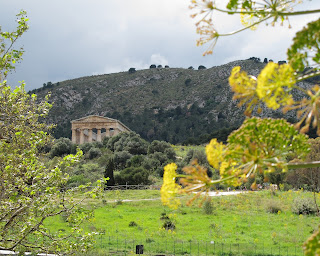 Greek `Egesta´,
ancient city of Sicily, located about two miles, (Three Kilometers)
northwest of modern Calathafimi. It was the chief city of the Elymi a
people for whom thucydides claimed a Trojan origin. They are
archaeologically indistinguishable in the Early Iron Age(
c.1000-c.500BC) from their Sicanian neighbours. Culturally Segesta
was Greek but it generally took the Cartrhaginian side against his
Greek neighbours, boundary disputes with Selenius, for instance were
frequent from 580n BC. onward. When in 409 Hannibal, son of Gisgo,
sacked Selenius Segesta became a Carthaginian ally.
Greek `Egesta´,
ancient city of Sicily, located about two miles, (Three Kilometers)
northwest of modern Calathafimi. It was the chief city of the Elymi a
people for whom thucydides claimed a Trojan origin. They are
archaeologically indistinguishable in the Early Iron Age(
c.1000-c.500BC) from their Sicanian neighbours. Culturally Segesta
was Greek but it generally took the Cartrhaginian side against his
Greek neighbours, boundary disputes with Selenius, for instance were
frequent from 580n BC. onward. When in 409 Hannibal, son of Gisgo,
sacked Selenius Segesta became a Carthaginian ally.
Early in the First Punic War,
however, the inhabitants massacred the Carthaginian Sarrison and
allied themselves with Rome . Segesta was favourably detracted under
Roman rule; it became a free city and the territory of Eryx may have
been assigned to it.
On a hill just outside
the site of the ancient city of Segesta lies an unusually well
preserved Doric
temple. It was built sometime in the late 5th century BC and has 6×14
columns on a base measuring 21×56m, on a platform three steps high.
Several things suggest that the temple was never actually finished.
The columns have not been fluted as they normally would have been in
a Doric temple and there are still tabs present in the blocks of the
base (used for lifting the blocks into place but then normally
removed).
It also lacks a cella
and was never roofed over. The temple is also unusual for being a
Hellenic temple in a city not mainly populated by Greeks.
The information about this temple in Segesta was found in Encyclopaedia Britannica by Alvaro, Jose ManuelSan and MariaQ - Thanks!
The information about this temple in Segesta was found in Encyclopaedia Britannica by Alvaro, Jose ManuelSan and MariaQ - Thanks!




No comments:
Post a Comment